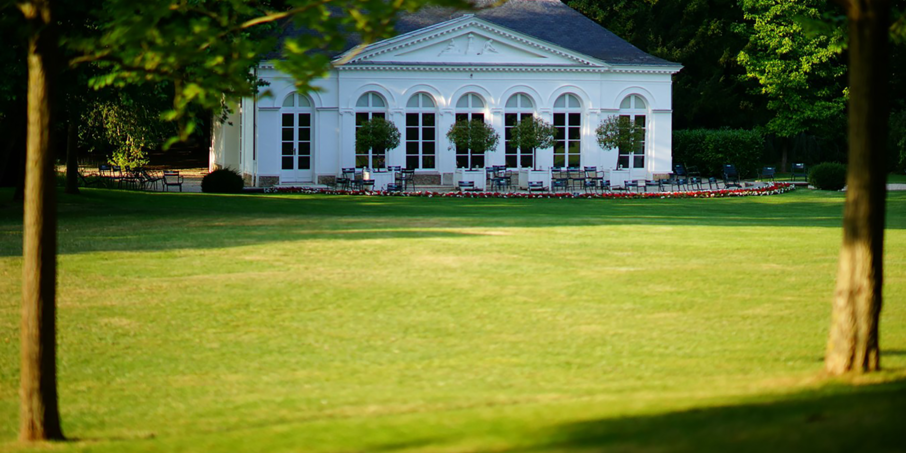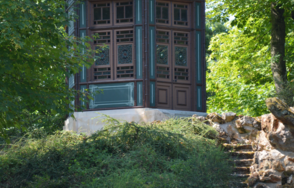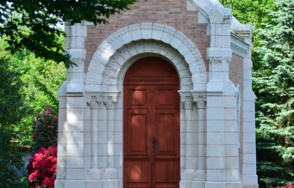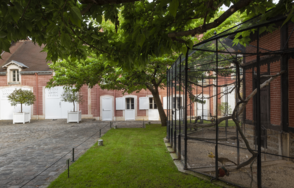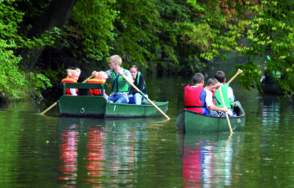A place to walk and relax
The “factories” or “ornamentation factories” are constructions of picturesque form, placed in the scenes of a landscaped garden. Originally “factory” is a purely pictorial term, designating the buildings which adorn the paintings in landscape painting. Under the influence of English theorists, garden designers were invited to work in the manner of painters: thus factories were born in parks.
In the 19th century, this fashion developed in France and the Yerres Valley was dotted with it: the smallest agricultural building would then be “dressed” to satisfy utility as well as beauty. The property is dotted with ornamental factories. The whole represents a unique ensemble of the romantic movement in landscape design from the beginning of the 19th century.
The House
The Palladian-style colonnade gives the Italian character to the dwelling house (the Casin de l’Italien casino, country house). The statues of Venus and Apollo, on the north facade, recall the taste of the bourgeoisie for the antique.
The Exedra
In the ancient world, the Exedra was a meeting room intended for conversations. Here, it symbolizes the journey through time, evoked by Greco-Roman statuary.
The Aviary
Installed in 1860 by Martial Caillebotte Sr., this factory welcomed birds sought after for their beautiful songs.
The Ornate Farm
Old name that garden theorists gave to agricultural buildings. It is discreetly decorated with colorful facings such as faux brick. This space dedicated to artists since 2008 (the Art and Exhibition Center) hosts temporary exhibitions.
The Swiss Chalet
This mountain chalet extends the buildings of the Ferme Ornée and covers what was the dairy. Its decoration is due to Martial Caillebotte, father of Gustave.
The Orangery
In neo-classical style, the Orangery was used for the wintering of ornamental orange trees, which appear in several paintings by Gustave Caillebotte. The building is today a temporary exhibition hall where we welcome artists from the region, but also established artists.
The Gateway
This small metal bridge spanned an old arm of the river, which was partially restored in 2006.
The Pier
Rent a boat or canoe to discover the landscapes of the banks of the Yerres dear to Caillebotte.
The vegetable garden
Passionate about horticulture, Caillebotte often painted the vegetable garden. With an area of 1700m2, we find the original greenhouse and the sump mechanism. It is today maintained by volunteers from the “Potager Caillebotte” association.
Starting Saturday January 22, 2022, opening at 3:30 p.m. from Maison Caillebotte.
The Chapel
Consecrated under the name “Notre-Dame du Lierre” in 1864, the chapel was built by Martial Caillebotte senior, in honor of his son, parish priest, Alfred. Its architecture incorporates elements of Romanesque and neo-Gothic style.
The cottage
This small house, mountain style and equipped with a small millstone, was and still is used for storing tools.
The Kiosk
The oriental kiosk is a gazebo pavilion dominating the landscape. It features wooden ornaments imitating bamboo, and stained glass windows with a motif of Griffons reminiscent of Mount Griffon, the highest point in the region.
The cooler
Overhung by the Kiosk, the Ice Box with a depth of 7m made it possible to have ice and preserve food. The access door is framed by a millstone rock in the shape of a cave. It is entered by means of a footbridge which takes the visitor into its heart.
The covered bench
Japanese-inspired, the covered bench is described as a rest stop for the traveler, from where he can contemplate the park.
Park rules
Extract from the municipal decree of September 26, 2017
Article 3: This green space is placed under public protection. Users are responsible for damage of any kind that they may cause by themselves, by people, animals or objects in their care.
Article 4: It is permanently prohibited to circulate in the paths, on the lawns of the park by car, motorcycle or any other motorized vehicle or bicycle (except for emergency vehicles and municipal vehicles, these on order special mission).
Article 5: Any vehicle parking is strictly prohibited in the park, including around the Orangery and the paved courtyard of the Casin.
Article 6: The public must maintain decent dress and behavior consistent with good morals and public order.
Article 7: The introduction and use of weapons of any kind, slings, bows and dangerous objects, are prohibited.
Article 8: It is strictly forbidden to explode firecrackers or use any fireworks, as well as to use any noisy device, to receive radio waves or to broadcast recorded media and, as a general rule, to disturb the peace and quiet of this public place.
Article 9: The public is required to respect the ownership of green spaces and their equipment. Trash of all kinds must be placed in the bins provided for this purpose.
Article 10: In order to ensure the protection of these places (...), it is prohibited: - To climb trees, break or saw branches of trees or shrubs, uproot shrubs, display and to paint on the trunks, to use the trees as a support, - To pull up or cut the plants or flowers, to take soil and throw stones.
Article 11: Painting (on canvas), photography and amateur cinematography are authorized in the park, provided they do not disturb walkers. Professional photography is subject to prior written authorization from the City.
Article 12: It is strictly and permanently prohibited to camp, bivouac or light fires with materials brought or found on site in the park.
Article 13: Domestic animals must be kept on a leash and access to lawns is completely prohibited.
Article 14: It is prohibited to leave any food such as meat or pâté, in order to feed stray, wild or reverted animals, particularly cats.
